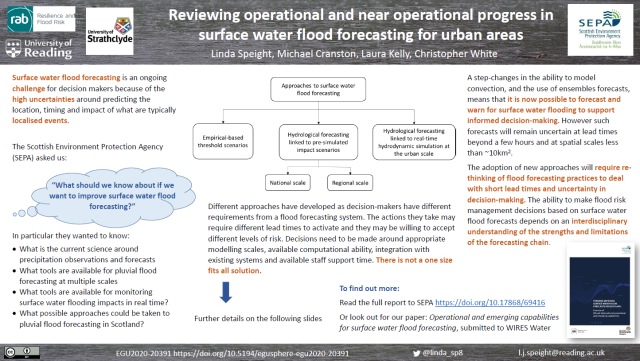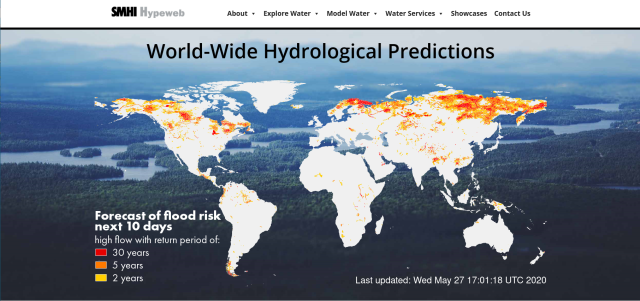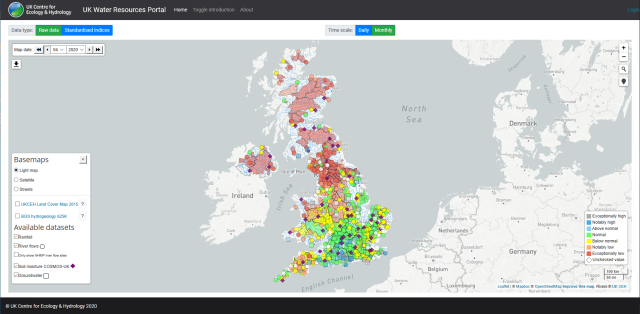For several years the ‘operational forecasting and warning systems‘ PICO session has been a popular feature of the EGU hydrological sciences program. However, with restrictions on travel and meetings in place due to Covid-19, the whole of the 2020 Assembly took on a new form – virtual. #shareEGU20 was a week long event taking place over the first week of May and freely available for anyone to join. Over 18,000 abstracts were published with 63% being presented virtually through various online displays, all of which were supported by over 200,000 discussion point or messages being posted by the virtual delegates.
As for the operational forecasting session, alongside the abstracts, 12 displays were presented with 120 people joining the discussion. To help with the facilitating, the conveners connected via video conference between New Zealand, Sweden, the Netherlands and Scotland to steer the presenters and discussion.
The diverse range of operational forecasting systems that were presented, included the implementation of an impact-based forecasting system in Barbados (University Corporation for Atmospheric Research, US) to experiences of co-developing flood forecasting in West Africa (Jafet Andersson, SMHI, Sweden).

Display on ‘Reviewing operational and near operational progress in surface water flood forecasting for urban areas’ by Linda Speight (University of Reading)
Co-convener Céline Cattoën-Gilbert (Hydrological Forecasting Scientist at NIWA) offered her highlights of the session: “Advances are being made in real-time inundation forecasting at national, regional and urban scales. For example, Linda Speight (University of Reading) presented an overview of the latest science, tools and approaches available for monitoring and forecasting flood impacts to inform future developments for the Scottish Environment Protection Agency (SEPA). With empirical-based threshold scenarios, hydrological forecasting chains linked to pre-simulated impact scenario for national or regional scales, or linked to real-time hydrodynamic simulation at the urban scale, there is not a one size fits all solution – a reflection of different decision-makers’ needs. The work presented by Alessandro Masoero (CIMA Research Foundation) follows the last approach by building an early warning system in Guyana at the national scale with real-time hydraulic inundation forecasts at selected locations. The adoption of real-time inundation forecasting approaches will require strong interdisciplinary efforts to support informed decision-making.”
As for the presentation on surface water flood forecasting, the delegate discussion focused on: whether there was a focus on a means of communicating the forecasts; on how pre-simulated impact scenarios compensate for the absence of real time modelling; and whether there were attempts to link these to crowd sourcing of information. More on this research and how scientists are tackling surface water prediction in this Conversation article from December 2019.

World-wide hydrological predictions using the HYPE model by SMHI as presented by Pechlivanidis (SMHI)
Ilias Pechlivanidis (Scientific Leader in Forecasts of Water Variables at SMHI) and another co-convener, said “a big effort is currently given on setting up early warning and climate services at the large scale with the objective to address local needs. Among the various interesting studies, Katie Smith (CEH) presented a proof-of-concept global hydrological outlook system developed by many international partners to increase resilience to hydro-climatic risks. The system is setup for the WMO under the HydroSOS topic to provide an overview of historical and forecast hydrological status. My co-author Jafet Andersson presented a number of operational hydrological forecasting services with applications in European, Niger river basin and global domain. The services provide information at medium-range, sub-seasonal and seasonal time horizons, whilst strong user engagement was followed in the co-design of the services addressing further the local user needs.”

The UK Water Resources Portal as presented by Lucy Barker (UKCEH)
Current talk of a potential drought in the UK links well to the presentation by Lucy Barker (UKCEH) on dynamic real-time hydrological status monitoring in the UK. Lucy’s presentation highlighted how understanding the current hydro-meteorological situation is critical to manage extreme events and water resources, illustrating how a new portal has been developed to enable dynamic, interactive, real-time access to hydro-meteorological data. This article highlights how the tool is providing a hydrological outlook for the current situation. There were other abstracts that were contributed and all of these and the displays for this session are available on the EGU20 pages.
Yes, I’m sure we’ll all admit to missing sharing stories and capabilities in the more familiar surroundings of the Austria Center Vienna, but has #shareEGU20 set a new benchmark in conferencing?
